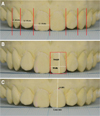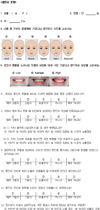Abstract
Purpose
This research is to investigate factors that affect dental aesthetics and analyze whether individual perception affects and difference of genders affects the esthetic factors.
Materials and methods
Seventy dental students of Chonnam University aged from 25 to 35 years old without periodontal problems were included. Maxillary dental cast for participants were made, and standardized photo was taken with a digital camera. Maximum visual width and the position of gingival zenith of maxillary anterior teeth and maximum height of the maxillary central incisors were measured by a measurement program and the shape of central incisor was categorized. Questionnaire was conducted to evaluate esthetic perception. SPSS program was used to perform statistical analysis.
Results
The average visual width ratio of right maxillary anteriors was 1.38:1:0.78 and 1.41:1:0.81 for the left which differ from the golden ratio. The width to height ratio for right and left central incisor was 0.84 and 0.83 respectively. The gingival zenith position was determined to be: mostly, central incisors and canines were located in the distal side, lateral incisors were located in the center. The visual width ratio of right maxillary anterior teeth, ratio of width to height of central incisor, gingival zenith position, crown morphology and amounts of gingival exposure upon smiling were not significantly different between genders, and facial patterns and these dental esthetic factors were not related to aesthetic perception.
Conclusion
Even though participants had the visual width ratio of maxillary anteriors or ideal width to ideal height of central incisors that did not agree with the golden ratio, they had high satisfaction for dental esthetics. Esthetic perception depends more on subjective judgements of participants than objective indices.
Figures and Tables
 | Fig. 1Measurement for dental esthetic factors. (A) The measurement of visible mesiodistal width, (B) Apicocoronal height for maxillary central incisor, (C) Determination of gingival zenith position (GZP) which is the highest gingival marginal point. |
Table 1
The maxillary anterior teeth width and W/H Ratio of maxillary central incisor according to gender

References
1. Moskowitz ME, Nayyar A. Determinants of dental esthetics: a rational for smile analysis and treatment. Compend Contin Educ Dent. 1995; 16:1164. 1166.

3. Brisman AS. Esthetics: a comparison of dentists' and patients' concepts. J Am Dent Assoc. 1980; 100:345–352.


4. Cooper GE, Tredwin CJ, Cooper NT, Petrie A, Gill DS. The influence of maxillary central incisor height-to-width ratio on perceived smile aesthetics. Br Dent J. 2012; 212:589–599.


5. Mattos CM, Santana RB. A quantitative evaluation of the spatial displacement of the gingival zenith in the maxillary anterior dentition. J Periodontol. 2008; 79:1880–1885.


7. Ahmad I. Geometric considerations in anterior dental aesthetics: restorative principles. Pract Periodontics Aesthet Dent. 1998; 10:813–822.
8. Hall WR. Shapes and sizes of teeth from American system of dentistry. Philadelphia: Lea Bros;1987. p. 981.
9. Heravi F, Rashed R, Abachizadeh H. Esthetic preferences for the shape of anterior teeth in a posed smile. Am J Orthod Dentofacial Orthop. 2011; 139:806–814.


10. Lombardi RE. The principles of visual perception and their clinical application to denture esthetics. J Prosthet Dent. 1973; 29:358–382.


12. Mahshid M, Khoshvaghti A, Varshosaz M, Vallaei N. Evaluation of “golden proportion” in individuals with an esthetic smile. J Esthet Restor Dent. 2004; 16:185–192.


13. Sarver DM. Principles of cosmetic dentistry in orthodontics: Part 1. Shape and proportionality of anterior teeth. Am J Orthod Dentofacial Orthop. 2004; 126:749–753.


14. Gürel G. The science and art of porcelain laminate veneers. Chicago: Quintessence;2004. p. 67–75.
15. Morr T. Understanding the esthetic evaluation for success. J Calif Dent Assoc. 2004; 32:153–160.

16. Chu SJ, Tan JH, Stappert CF, Tarnow DP. Gingival zenith positions and levels of the maxillary anterior dentition. J Esthet Restor Dent. 2009; 21:113–120.


17. Ong E, Brown RA, Richmond S. Peer assessment of dental attractiveness. Am J Orthod Dentofacial Orthop. 2006; 130:163–169.


18. Anderson KM, Behrents RG, McKinney T, Buschang PH. Tooth shape preferences in an esthetic smile. Am J Orthod Dentofacial Orthop. 2005; 128:458–465.






 PDF
PDF ePub
ePub Citation
Citation Print
Print









 XML Download
XML Download